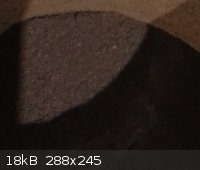ElizabethGreene
Hazard to Others
  
Posts: 141
Registered: 15-10-2012
Member Is Offline
Mood: No Mood
|
|
Production of small quantities of crude Wood Charcoal Carbon powder
Reporting results, feedback welcomed.
Abstract: Description of a procedure used to produce small quantities < 250 grams of crude wood charcoal via Spaghetti-Sauce-jar
Pyrolysis is presented.
Detail: A large quantity of paper, approximately 2m3 loosely packed was slated for disposal by incineration in a 55 Gallon
"Burn Barrel." This paper was unprinted newspaper formerly used to pack fragile items for a household move. This paper was added loosely to the burn
barrel and ignited. Additional paper fuel was added at irregular intervals. Approximately one hour after ignition, boredom commenced and the
following experiment begun.
A clean glass spaghetti sauce jar with a screw-on lid was obtained. This jar was packed 1/3 full with green wooden deciduous tree sticks ranging from
1-3 cm in diameter. The lid was placed on and perforated with a number of small slits at knifepoint. The jar was then ceremoniously chunked into the
burn barrel. Additional fuel was added repeatedly and the ashes and unburned fuel agitated occasionally for a total burn time of roughly 30 hours.
Upon cooling the jar was retrieved and opened. The "sticks" had carbonized and were now uniformly black color throughout their cross-section. A very
small quantity of ash (< 0.1 g) was also found in the jar. A brown unidentified substance (tar?) had condensed on a portion of the inside of the
jar.
The wood charcoal sticks were placed in a (dedicated for lab use) blender and pulsed for approximately 60 seconds resulting in a fine gray-black
powder. This was screened through a 20 mesh wire screen and the particles not passing through the filter discarded. The product was placed in a
clean jar and labeled "Wood Charcoal carbon powder <20 mesh".
The reaction vessel (WP_001216.jpg)

The final product (WP_001214.jpg)

Self-Criticism:
1. This product almost certainly contains a number of impurities, specifically "Pot-ash" salts of sodium, potassium, and calcium. As such, it should
not be used for critical reactions without further processing. Many of these salts are water soluble, so a simple water wash and filtration should
greatly improve the quality of the product.
2. The experiment is poorly repeatable. A better procedure would record the burn temperature and duration, the quantity of wood placed in the vessel
and the amount of product retrieved.
Future work:
This product will be used in a future attempt to reduce Tin Oxide to Elemental Tin.
|
|
|
watson.fawkes
International Hazard
    
Posts: 2793
Registered: 16-8-2008
Member Is Offline
Mood: No Mood
|
|
It's pine tar, or
at least it is if you used pine wood. With pine, there's enough of it for it to have been an item of commerce for centuries. All woods, however,
produce some such tar when dry distilled. The analogous process for coal yields coke and coal tar. The longer and hotter the burn, the lower yield of
tar, as it cracks and evaporates off.
A side-cutting can opener leaves a rim on the lid that allows it to nestle back on the can snugly. All it takes to make a decent retort is some
bailing wire to affix the lid in place and a hole punched the top (a nail works) so the methanol and other distillation gases can escape.
|
|
|
bfesser
Resident Wikipedian
    
Posts: 2114
Registered: 29-1-2008
Member Is Offline
Mood: No Mood
|
|
<strong>ElizabethGreene</strong>, I love your writeup. Very entertaining style. Please, <em>stick</em> around for a while!
(I couldn't think of a decent <a href="http://en.wikipedia.org/wiki/Tar" target="_blank">tar</a> <img src="../scipics/_wiki.png" />
or <a href="https://en.wikipedia.org/wiki/Charcoal" target="_blank">charcoal</a> <img src="../scipics/_wiki.png" /> pun, sorry.)
[Edited on 7/9/13 by bfesser]
|
|
|
Poppy
Hazard to Others
  
Posts: 294
Registered: 3-11-2011
Member Is Offline
Mood: † chemical zombie
|
|
How didn't you melt the glass in this process?
Don't be pessimist this tye of charcoal if often considered one of the best samples for BP manufacture.
Even, if you want very activated forms for other purposes, you can grab a piece of amber and tap that into a jar until combustion fades out. WARNING:
this type of charcoal is said to autoignite espontaneously on exposure to air!!
|
|
|